
According to R. Abraham Twerski, Abe Lincoln once said:
“I do not like that man very much. I should get to know him better.”
When my kids were in nursery school, they used to do this project that I loved. They would bring home a present, and inside the present was a paper book and a toy sword. Why? Keep reading.
In this week’s parsha of Vayishlach, Yaakov prepares to meet Esav, whom he has not seen in many years. Through messengers, Yaakov learns that Esav his brother still does not like him and is headed to see him with an army of 400 people. So what does Yaakov do to prepare? Rashi says he readied himself for three things: paying tribute (the present), prayer (the book, representing a siddur) or war (the sword or knife).
I’ve heard peaceniks and hawks both use this parsha to justify their approach to enemies. But I’m not sure Abe Lincoln’s quote really is valid for dealing with a whole nation of belligerents.
So who’s Timna? At the end of the parsha, it says: “And Timna was concubine to Eliphaz Esau’s son; and she bore to Eliphaz Amalek. ” Why is this relevant? According to Sanhedrin 99b, her son Amalek became the archenemy of Judaism because she had been rejected by Avraham, Yitzchak and Yaakov as a convert. Rabbi Twerski suggests that even if they had needed to reject her, they could have done it in a nicer way.
So this parsha really does have a lot to say about war and enemies. You may have some ideas about how some of this could be relevant today. If I had to come up with some good idea, I would never be able to hit the ‘Publish’ button, so here’s the post as is.
 Ilana-Davita has more on settling disputes and this parsha.
Ilana-Davita has more on settling disputes and this parsha.

JPIX #21, a blog carnival of pictures by Jewish bloggers, is up at Mother in Israel. Thank you for including my fall foliage and stars watercolor.
What else is going on in the blogosphere:
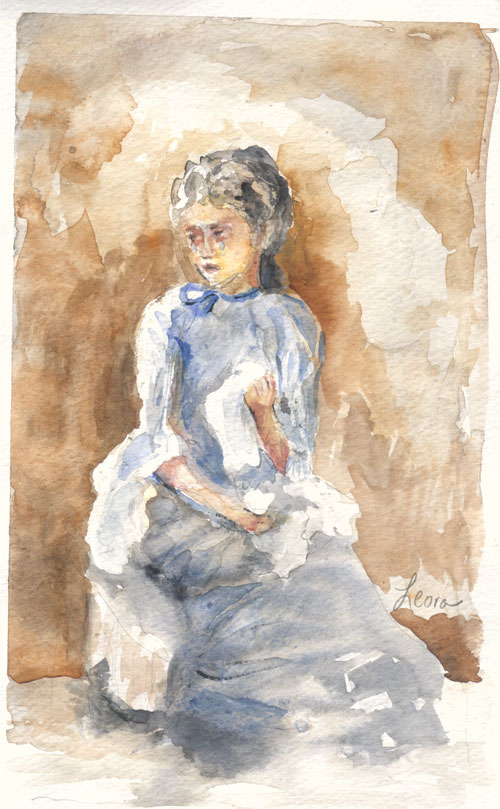
וְעֵינֵי לֵאָה, רַכּוֹת
And Leah's eyes were weak (Genesis 29:17)
Poor Leah. She cried, because she thought she would get stuck with Esav (Rashi says weak eyes meant they were weak from tears). Instead, she married Yaakov, but she knew that he really loved her sister, Rachel, best.
On Wednesday I asked how Rachel helped out Leah, and how Leah helped out Rachel. Here’s Rashi’s explanation:
Rachel had signs from Yaakov to show that it was she and not someone else when they got married. However, Rachel taught the signs to Leah, so Leah would not be embarrassed.
Leah helped Rachel out by praying for a girl when she was pregnant with her 7th child. She knew that Yaakov would only have 12 sons, and Bilhah and Zilpah already had 2 each. She wanted Rachel to have at least two sons.
As Lion of Zion pointed out, there are also interpretations that say Leah and Rachel were not so nice to each other. But that’s a subject for another post. Maybe next year.
(One more thought: as I tend to prefer a commentary that is sympathetic to the matriarchs, especially to their sadness, as opposed to one that might highlight cattiness, I’m not sure I’m gonna like these other views).
More on this week’s parsha of Vayetze:
 Ilana-Davita writes about how human the personalities of this parsha are; strong emotions are part of our lives.
Ilana-Davita writes about how human the personalities of this parsha are; strong emotions are part of our lives.
Special thanks to Winslow Homer for his help with the watercolor painting.

This watercolor is available for a limited time (until I do another one I like a lot!) for purchase as a greeting card at my Cafepress store.

This is the watercolor I painted for a post on the age of Rivka. I decided in order to paint I need 1) my children to be out of the house (OK if eldest is home) and 2) not a lot of time. If I have a lot of time, I will fritter it away, checking blogs, doing laundry, running errands, catching up on whatever household stuff I couldn’t get to when I had too much work on my plate.
You will notice the paper is rather rough; it’s fun to experiment with different types of paper. Also, because much of a bride is white, I had to concentrate on the negative space, the parts of the composition that were not bridal veil, dress or flowers.
“Not painting because it’s too much fun is like not going outside on a pretty day because the weather is too nice.” – Sh, a dear friend
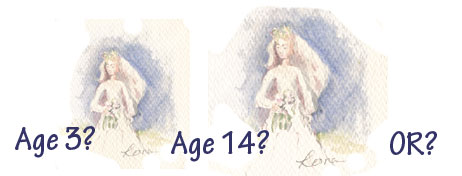
Was Rivka 3 or 14 or some other age when she got married?
 Josh Waxman has much more on this topic.
Josh Waxman has much more on this topic.
But for us in the 21th century, either age seems young. One can see advantages to marrying someone off at fourteen; it (mostly) eliminates the problem with teenage pregnancies, as the girl/woman is married. She was also marrying someone who shared her culture, even if one family worshiped one God and the other worshiped idols. On the other hand, it doesn’t give her anytime to develop a career or even any sense of herself before having children. I can’t even begin to imagine a married 3-year-old, unless it was just a betrothal. Then, married fourteen-year-olds also seems like a strange notion…
This post is a continuation of 100 20 7 14 3. More on the 127, coming soon.
Westbankmama has posted a lovely Mama Rachel edition of Haveil Havalim. In this weekly blog carnival of the Best of the Jewish Blogosphere she linked to my post on Hospitality, which has the watercolor at the bottom of this post.
In the middle of the blog carnival, there is a lovely watercolor by an artist blogger named Carol Feldman. What a special treat! Thank you, Westbankmama, for hosting.
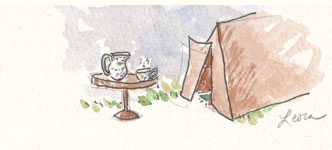
 In this week’s parsha of Vaera we learn about hospitality, known in Hebrew as Hachnasat Orchim, welcoming guests. We have two examples of hospitality, one as Abraham welcomes three men (it does not say angels in Genesis 18:2) and another of Lot, who invites two angels to visit him.
In this week’s parsha of Vaera we learn about hospitality, known in Hebrew as Hachnasat Orchim, welcoming guests. We have two examples of hospitality, one as Abraham welcomes three men (it does not say angels in Genesis 18:2) and another of Lot, who invites two angels to visit him.
How is Abraham’s hospitality different from that of Lot? For one, Abraham welcomed three men whom he saw as wanderers, not as angels, whereas Lot invited in angels. Rabbi Frand (from Rabbi Frand on the Parashah 2) differentiates the two greetings; Abraham welcomed men wandering through the wilderness, Lot was only welcoming because he saw angels. But at the same time, Lot had learned something from Uncle Abraham’s example.
Rabbi Frand writes:
Lot…saw angels. Lot was hospitable, but he wasn’t going to have just anyone at his house… Lot had learned enough from his uncle Avraham to invite the angels in, but he had not learned a most important lesson: you don’t handpick your guests. True hachnassas orchim is to make everyone feel welcome at your home, angel or human. And human, we might add, applies to all humans, even those that come from the less genteel segments of society.
Rashi brings another difference in their hospitality. Abraham requested that the travelers remove the dust from their feet first and then enter. Lot invited them to enter with dusty feet. Abraham saw his guests as worshipers of dust and did not want to bring their idol worship into his home. Lot, on the other hand, knew that the people of Sodom objected to Hachnasat Orchim so to protect the visitors suggested the guests remain with dust on their feet so it would appear as though they had just arrived.
I do like having guests over, though I can’t say I always feel up to it; some weeks I feel more inclined to entertain than others. But I do welcome my daughter’s complaint when we don’t have guests (“no guests this week?” she has been known to say). I like that she appreciates Hachnasat Orchim, welcoming guests into our home.
Finally, I struggle with Rabbi Frand’s idea of welcoming anyone into one’s home. Anyone else have their doubts or thoughts about this?
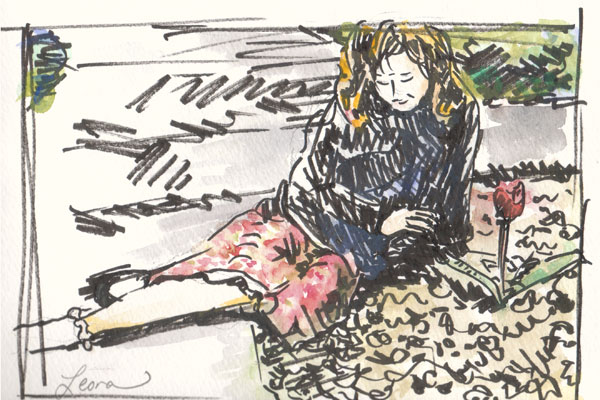
I did this with ink pens, and then for the color I applied watercolor paints. It is a study for a painting that I’ve started. It may take me months to finish. I’m in no rush.
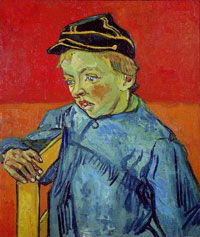 A reader wrote to me saying she is never quite sure how to comment on an image. I realized that my many years of art training helps me comment on photography and art. So I’m hoping that with this post we can help those who would like help with imagery commenting ideas. If you have suggestions to offer, please leave some in the comments. I may add to the post with some of your ideas.
A reader wrote to me saying she is never quite sure how to comment on an image. I realized that my many years of art training helps me comment on photography and art. So I’m hoping that with this post we can help those who would like help with imagery commenting ideas. If you have suggestions to offer, please leave some in the comments. I may add to the post with some of your ideas.
Using a list of formal elements I learned from an art teacher, here are some ideas:
- Medium and materials: what did the artist/photographer use to create the image? One could ask a question or comment about the camera, the lighting, the photo editing software.
- Composition: what is placed where in the composition? How is the rectangle (if it is one, and it usually is) broken up? Example: “An expected composition, with a diagonal going down one side where one would expect a vertical”
- Color: is it one color? Many colors? Bright colors? Contrasting colors? Do they colors appeal to you? Example: “Love the combination of purples with reds and greens”
- Light: What is the light source of the subject? How does it effect the overall presentation? Is it warm, cool, natural, artificial?
- Style: Does it remind you of a certain style or school of artists? Is it realistic or fantasy-like? Pop art? Classical?
- Depth: How far back does the photo/painting take you? Are you close to the subject or far away? How did the artist achieve those results? Example: “Wow, that field is vast” or “the dog looks like he’s going to jump right out of the picture and unto me!”
- Motion: Did the artist/photographer create motion in the image? Does that feel good or make you dizzy?
- Theme, Mood: Is there a basic theme to the image? Loneliness? Glee? Serenity? Chaos? Disconnect? Family bonding? If you think a photo has a certain theme, you can ask if that’s what the photographer intended. Or just say, “serene”, if you are staring at a calm lake surrounded by colorful fall trees.
For further reading:
 Formal Visual Analysis
Formal Visual Analysis
 Composition and Design Principles
Composition and Design Principles
If you would like to test out some of these descriptive ideas, you may comment on the painting in the upper right corner by Van Gogh. Click on it to see a larger version and more information.

 Ilana-Davita has more on settling disputes and this parsha.
Ilana-Davita has more on settling disputes and this parsha.







